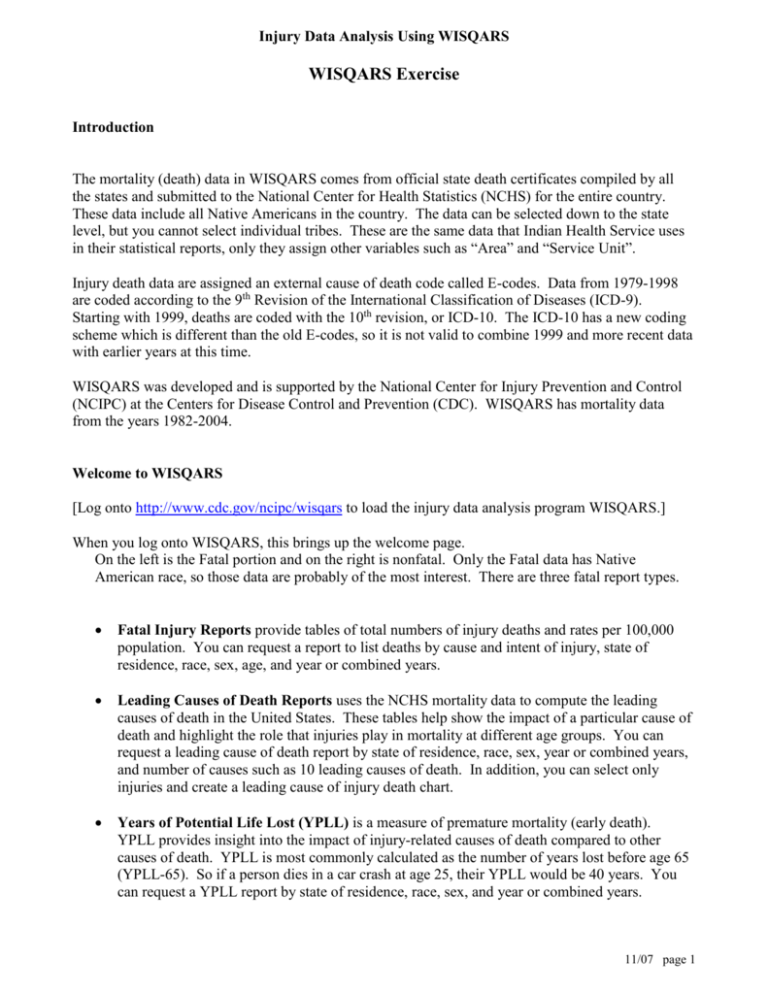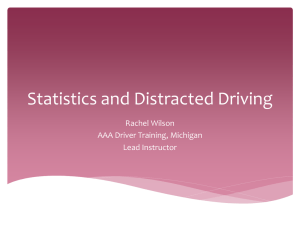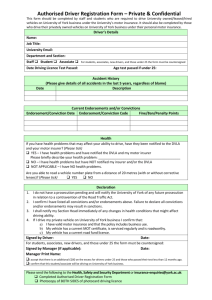WISQARS Exercise
advertisement

Injury Data Analysis Using WISQARS WISQARS Exercise Introduction The mortality (death) data in WISQARS comes from official state death certificates compiled by all the states and submitted to the National Center for Health Statistics (NCHS) for the entire country. These data include all Native Americans in the country. The data can be selected down to the state level, but you cannot select individual tribes. These are the same data that Indian Health Service uses in their statistical reports, only they assign other variables such as “Area” and “Service Unit”. Injury death data are assigned an external cause of death code called E-codes. Data from 1979-1998 are coded according to the 9th Revision of the International Classification of Diseases (ICD-9). Starting with 1999, deaths are coded with the 10th revision, or ICD-10. The ICD-10 has a new coding scheme which is different than the old E-codes, so it is not valid to combine 1999 and more recent data with earlier years at this time. WISQARS was developed and is supported by the National Center for Injury Prevention and Control (NCIPC) at the Centers for Disease Control and Prevention (CDC). WISQARS has mortality data from the years 1982-2004. Welcome to WISQARS [Log onto http://www.cdc.gov/ncipc/wisqars to load the injury data analysis program WISQARS.] When you log onto WISQARS, this brings up the welcome page. On the left is the Fatal portion and on the right is nonfatal. Only the Fatal data has Native American race, so those data are probably of the most interest. There are three fatal report types. Fatal Injury Reports provide tables of total numbers of injury deaths and rates per 100,000 population. You can request a report to list deaths by cause and intent of injury, state of residence, race, sex, age, and year or combined years. Leading Causes of Death Reports uses the NCHS mortality data to compute the leading causes of death in the United States. These tables help show the impact of a particular cause of death and highlight the role that injuries play in mortality at different age groups. You can request a leading cause of death report by state of residence, race, sex, year or combined years, and number of causes such as 10 leading causes of death. In addition, you can select only injuries and create a leading cause of injury death chart. Years of Potential Life Lost (YPLL) is a measure of premature mortality (early death). YPLL provides insight into the impact of injury-related causes of death compared to other causes of death. YPLL is most commonly calculated as the number of years lost before age 65 (YPLL-65). So if a person dies in a car crash at age 25, their YPLL would be 40 years. You can request a YPLL report by state of residence, race, sex, and year or combined years. 11/07 page 1 Injury Data Analysis Using WISQARS WISQARS Exercise Source: WISQARS Help file: http://www.cdc.gov/ncipc/wisqars/fatal/help/helpfile.htm Small Numbers of Death Because the American Indian/Alaska Native population is small and injury deaths are a relatively rare event, you may need to combine years of data in order to get large enough numbers to analyze and to calculate a stable rate. The NCHS considers any rate based upon 20 or fewer deaths to be an unstable rate. This means that the rate may be due to chance and not necessarily reflect the true death rate in the population. Having larger numbers to base the rate on gives you more confidence that the rate is representative. For example, when looking at motor vehicle deaths in Arizona, 1999, to Native American teens, there were 21 deaths (4 female; 17 males). The total rate would be considered OK, but the rates for males and females would be unstable. To analyze by sex, you would need to combine 2 or 3 years or even more for females. WISQARS shows unstable rates colored white with a *. The Leading Causes of Death report and YPLL will work best for Native Americans by combining years of data, for example 3 years: 2002, 2003, and 2004. This will give more numbers to look at. For Fatal Injury Reports, if states are chosen, then combining 3 years of data may also be needed depending on the injury cause. Instructions: Follow the steps outlined to generate information from WISQARS on your computer screen. Where applicable, record your answers to questions immediately following the question. If you get stuck, please ask for assistance from the instructors. Use your “Back” button to go back to the WISQARS screen after each analysis run. 1. Learning about Leading Causes of Death Part One: o Click on Leading Causes of Death Reports from the main WISQARS menu. o Click on Data from 1999 and later. o Under “Report Options” select the state you live in. Select American Indian/Alaska Native race. o Select the years 2000-2004. o Click on Submit Request to calculate the 10 Leading Causes of Death, then write down the top 5 leading causes of death (ranked 1-5) overall for all ages. o What are the top 3 ranked causes of death for ages 15-24? Where do motor vehicle crashes rank as a leading cause of death for all ages? (Hint: click on the Unintentional injury title in the blue box to see what comprises that category or ask for assistance) Remember to hit the “back” button to go back to the WISQARS screen after each analysis run. 11/07 page 2 Injury Data Analysis Using WISQARS WISQARS Exercise Part Two: o Select Arizona and the same years. (If your state is AZ, select a state other than AZ) o Submit request to calculate the 10 Leading Causes of Death for American Indians and Alaska Natives. Write down the top 5 (ranked 1-5) leading causes of death for all ages. Using the chart, answer the following questions: How are the leading causes of death ranked differently in your state than in Arizona? Where do motor vehicle crashes for all ages rank as a leading cause of death for American Indians in Arizona? (Hint: click on the Unintentional injury title in the blue box to see what comprises that category and/or ask for assistance) 2. Learning about Leading Causes of Injury Death Part One: o Click on Leading Causes of Death Reports from the main WISQARS menu. o Select data from 1999 or later o Select the state you live in. Select American Indian/Alaska Native race. o Select the years 2000-2004, top 10 number of causes, 1-14 in 5-year groups, 15-65+ in 10 year groups o Under “Advanced Options” select All Injuries o Submit request to calculate 10 Leading Causes of Injury Death. Using the chart generated, answer the following question: What are the top five causes of injury death for all ages in your state? 3. Comparing Motor Vehicle Death Rates by State, Race, and Nationally Part One: o From the main menu, click on Injury Mortality Reports. o Under “Report Options” select all intents, select motor vehicle, overall o Select your state. o Select the years 2000-2004. o Under “Advanced Options” select output groups for sex and race o Submit request to calculate the overall motor vehicle crash rates by race (White, Black, and American Indian), and sex (male/female). Write down the answers using age adjusted rates for males. 11/07 page 3 Injury Data Analysis Using WISQARS WISQARS Exercise Once complete, answer the following questions: How does the American Indian males rate compare to White males and Black males in your state? Hint: Using a calculator or by hand divide the highest rate by the lower rate to calculate a proportion, such as “the White rate is 1.5 times greater than the Black rate.” Are male Indian rates higher than female? If yes, how much higher are they? Part Two: o o o o From the main menu, click on Injury Mortality Reports, data from 1999 and later. Select United States. Select the years 2000-2004. Calculate an Overall Motor Vehicle death rate, all intents, for all AI/AN in the United States. Write down your answer. o Calculate an Overall Motor Vehicle death rate for all races in the United States—a National all US races rate. Write down your answer. 3. Comparing AI/AN Age-Specific Motor Vehicle Death Rates in your State Part One: o From the main menu, click on Injury Mortality Reports. o Select your state. o Select the years 2000-2004. o Under “Output Groups” select Age Groups o Calculate overall motor vehicle death rates by age group for AI/AN, both sex combined. (Hint: don’t select age-adjust). Once complete, answer the following question: What age groups have the highest rates? 11/07 page 4 Injury Data Analysis Using WISQARS WISQARS Exercise 4. Learning about the Leading Causes of Motor Vehicle-Related Death Rank the leading causes (occupants, pedestrians, motor cyclists, bikes, etc) of motor vehicle crashes for AI/AN in your state. o o o o o From the main menu, click on Injury Mortality Reports. Under “Report Options” select Unintentional, then select motorcyclist. Select your state. Select the years 2000-2004. Calculate the number of motorcyclist deaths. Do the same for Occupant, Pedal Cyclists, and Pedestrian. Write down your answers. Once complete, answer the following questions: What percentage of the total motor vehicle traffic crash deaths for AI/AN in your state are Occupants? What percent are Pedestrians? How about Pedal Cyclists and Motor Cyclists? (Hint: divide the number of Occupant deaths by the total number of motor vehicle traffic deaths to determine the percentage.) Write down your answers. 5. Comparing “Area” AI/AN rates to the national rate for 2004. Calculate a regional “Area” simple rate for AI/AN overall motor vehicle crash deaths. Select the year 2004. Select American Indian race. Calculate the number of motor vehicle crash deaths for each of the states which comprise your IHS Area: example, if you are from Phoenix Area, then look at the states of Nevada, Arizona, and Utah. Write down the number of MV deaths from each state, and the AI/AN population in each state. For students from single state areas, (Oklahoma, etc.) combine your state rate with 2 neighboring states to calculate a regional rate. Rate Calculation: 2004 regional Motor Vehicle rate for AI/AN: Total # of AI/AN MV deaths X 100,000 Total AI/AN state Population in 2004 11/07 page 5 Injury Data Analysis Using WISQARS WISQARS Exercise 6. Optional Bonus Questions: Learning to Calculate Excess Deaths Calculating the estimated number of excess deaths is a powerful way to show the impact of injuries among Native Americans compared to National rates or state rates when one rate is higher than another. Think of it as if the Native American suicide rate were the same as the national rate, then ______ Native American lives would have been saved. Calculating Excess Death 2004: Part One: 7. From the main menu, click on Injury Mortality Reports. 8. Select your state. 9. Select the year 2004. 10. Calculate the MV death rate for AI/AN in your state. 11. Calculate a national (all states) all US races combined MV death rate. 12. Subtract the National rate from the Native American rate in your state. Note: This gives you the Excess Rate. Note: If the Native American rate is lower than the National rate, then select Arizona as the state instead of your state. Part Two: 13. Calculate the number of excess deaths by multiplying the excess rate times the 2004 Native American population in your state; then divide by 100,000. Excess # of Deaths = Excess Rate X 2004 AI/AN Population 100,000 ________________ = ________________________________ 100,000 Part Three: 14. Answer the question: “In [insert your state] _____________ [insert excess # of Deaths] _____________ American Indian lives would have been saved if the motor vehicle death rate were the same as the national rate. 11/07 page 6 Injury Data Analysis Using WISQARS WISQARS Exercise Other Reports 1. Using Injury Mortality Reports, calculate suicide rates by race and sex for your state for years 2000-2004. 2. Using injury Mortality Reports for years 2000-2004 calculate a drowning rate for ages 25-54 for AI/AN and for all races combined. How does the AI/AN Drowning rate for ages 25-54 compare to the rate for all persons 25-54 years of age in the United States? Does WISQARS provide any information about the cause of drowning such as watercraft related, bathtub drowning, etc.? 3. Using Injury Mortality Reports calculate unintentional Fall death rates by race and sex for your state. How do American Indian rates compare to Whites and Blacks in your state? 4. Years of Potential Life Lost (YPLL) Click on Years of Potential Life Lost Reports from the main WISQARS Menu. Select 1999 and later Select the state you live in. Select American Indian/Alaska Native race. Calculate YPLL before age 65 for years 2000-2004 for all intents, all injuries. Calculate YPLL before age 65 for years 2000-2004 for all intents, motor vehicle overall. 11/07 page 7






